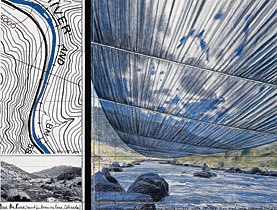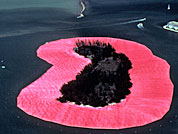A ‘scream of freedom’ over the river

All being well in 2012, artists Christo and Jeanne-Claude will suspend huge swathes of silvery fabric along a 64km stretch of Colorado's River Arkansas.
swissinfo met the controversial artists at an exhibition of their current artwork in progress, “Over the River”, which opened on Friday at Lausanne’s Fondation de l’Hermitage Museum.
The 73-year-old eccentrics, who are famous for wrapping up Berlin’s Reichstag building and surrounding Miami islands in shocking-pink fabric, were in Switzerland to drum up support for their monumental new work.
“We have close relations with Switzerland, as Swiss museums and private collectors have been collecting our work right from the start. And without collectors we cannot live, as if we cannot sell our work we cannot build our projects,” said Jeanne-Claude, with her striking dyed-red hair and matching lipstick.
The couple, who have been building huge environmental sculptures for over 40 years, do not accept any public funding or corporate sponsorship. And their team estimates that “Over the River” will cost $50 million (SFr57.9 million), funded by the artists and sales of their work.
So far they have spent more than $2 million on the new project, which was first conceived when a piece of torn fabric fluttered over the River Seine as they mummified the Pont Neuf Bridge in Paris in 1985.
The artists began a three-year search for suitable locations in 1992, covering 22,500 kilometres in six states to evaluate 89 river locations, before narrowing down their choice to the Arkansas.
The river is the busiest rafting river in the US with 300,000 rafters a year. The artists have designed an installation that can be enjoyed by drivers, walkers and kayakers.
Using massive reflective, translucent fabric panels to highlight the contours of the riverbanks, the aerial river will poetically mirror the meandering Arkansas.
“You can see it from above, a succession of silver panels like waves on the ocean, not transparent. But when you raft, the project will be above you and you can see the clouds and contours of the mountain through the fabric,” said Christo in his thick eastern European accent, squinting through heavy glasses.
Controversial
While tourism officials support the project, there is certain local resistance.
“All our works generate opposition,” said Jeanne-Claude. “By wrapping the Reichstag we were crucifying Germany’s history, for “The Gates” in Central Park we were painting a moustache on the Last Supper, as Central Park is considered a masterpiece of urban landscape architecture.”
“We are lucky with ‘Over the River’ as we have a very large local support group, but the much smaller group against us is very vocal.”
“People really don’t like to be disturbed in their everyday life,” chipped in Christo, who has an uncanny resemblance to filmmaker Woody Allen.
“They like to keep things the same and not be inconvenienced. Our biggest difficulty is that our projects attract too many visitors… we are trying to restrain publicity and work with environmental agencies to ease the traffic.”
Twenty-five years after the idea was first dreamed up, they are still waiting for the permit from the Bureau of Land Management to install the project.
But this kind of working timeframe is nothing unusual for Christo and Jeanne-Claude. Their Reichstag project took 24 years to be completed, The Gates in New York (2005) 26 years, and the spooky 178 wrapped trees in Basel (1998) 32 years.
“It’s not so much a matter of patience but rather passion,” said Jeanne-Claude, in reply to what keeps them motivated. “We want to do what we want, where we want and how we want it – that is the scream of freedom.”
Irrational, unique, temporary work
Although their work is visually striking and often contentious, the artists have denied there is any deep meaning behind it all.
Christo refers to his work as “irrational, irresponsible and useless”.
Like all their other installations, “Over the River” will only be open for two weeks before being removed. There will be no lasting signs of the brief existence of this temporary work of art.
“Permanence is the enemy of freedom,” said Christo. “We don’t own these projects. They are beyond our ownership. Nobody can buy these projects or charge tickets or control them.”
“People who come are aware that they are experiencing something unique. And while they are physically experiencing it, they know that it will just become a memory, something ‘once in a lifetime’.”
Next week, after returning home from Switzerland, the duo will fly to Colorado to sign a contract with a company preparing an environmental impact statement on the project for the authorities.
This is the first time in the US that a work of art has been subject to such a procedure, which is normally reserved for large-scale infrastructure such as new airports or gas and oil drilling facilities.
Despite the fact that the rubberstamp process could take up to two years, they seem confident. Over 45 years they have realised 20 projects and failed to get permission for 38.
“But if you talk to architects, they say the ratio is pretty good,” said Christo.
“For each work there are two periods of ecstasy and elation,” said Jeanne-Claude. “Firstly when we get the permit and then when we see the project completed as it’s always a billion times more beautiful than our wildest dreams.”
swissinfo, Simon Bradley in Lausanne
Christo (Christo Vladimirov Javacheff) and Jeanne-Claude (Jeanne-Claude Denat de Guillebon) are a married couple who have been creating environmental installation art over the past 40 years.
Some of their most famous works include wrapping the Reichstag parliament building in Berlin (1995) and the Pont Neuf Bridge in Paris (1985), a 24-mile-long fabric curtain called the “Running Fence” in Marin and Sonoma counties in California (1976), and most recently “The Gates”, in New York Central Park (2005).
In Switzerland they wrapped their very first public building, the Kunsthalle in Bern, in 1968, followed by the floors, stairways and windows of the Architecture Museum in Basel in 1984 and 178 trees in the grounds of the Fondation Beyeler and Berower Park in Basel in 1998.
Christo and Jeanne-Claude were born on the same date, June 13, 1935.

In compliance with the JTI standards
More: SWI swissinfo.ch certified by the Journalism Trust Initiative





You can find an overview of ongoing debates with our journalists here. Please join us!
If you want to start a conversation about a topic raised in this article or want to report factual errors, email us at english@swissinfo.ch.